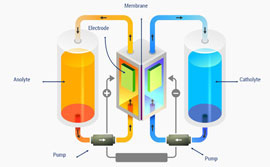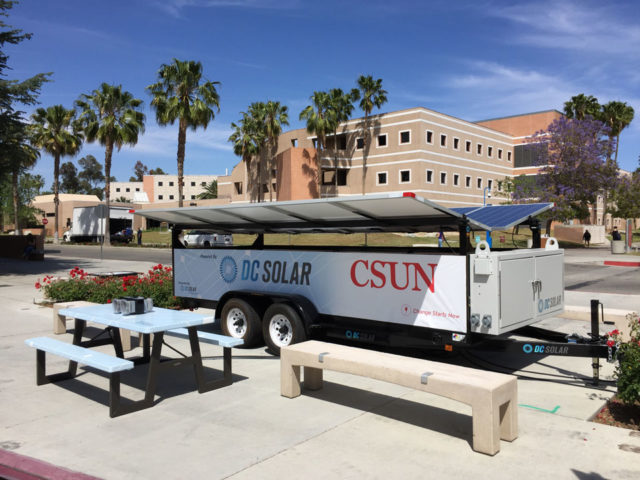Microgrids
North America

– NY Opens Door to Round 2 of $40MM NY Prize Challenge
NY Governor Andrew M. Cuomo opened the door to another $8 million in community microgrid funding opportunities April 20 with the launch of Stage 2 of the landmark $40 million NY Prize Program, the first of its kind in the US.
The 88 prospective community microgrid project developers who won Stage I grants to carry out community microgrid feasibility studies enter Stage 2 of the competition. The developers must provide detailed engineering design and financial and business plans. The RFP deadline for Stage 2 is October 12, 2016.
Building out microgrids is an important facet of NY’s Reforming the Energy Vision (REV) strategic plan, as well as critical to the state reaching its renewable energy generation goals.
“This competition will help make communities more resilient as well as bring New York one step closer to its goal toward achieving 50 percent renewable energy by 2030,” Governor Cuomo stated. “By creating strong local power networks, we can help modernize our energy grid while providing clean, reliable power to New Yorkers for years to come.”
International
– US, Romanian University Sign Microgrid Research Agreement
US Ambassador to Romania Hans Klemm and Mihnea Costoiu, the rector of University Politehnica Bucharest (UPB), signed an agreement via which the US Trade and Development Agency (USTDA) will fund research to assess the technical, economic and financial viability of building a smart microgrid pilot system on the university’s campus.
UPB is the largest, oldest and most prestigious technical university in Romania, according to an April 21 Act Media news report. Maryland’s E3 International, the consulting firm that will conduct the research, is contributing $125,854 of the $506,516 grant.
“By employing the latest smart grid and intelligent building technologies, Politehnica Bucharest will be able to better regulate its energy, maintenance and operation costs,” Ambassador Klemm said.
Solar Power

– Solar Now Cheaper than Coal, India’s Energy Minister Says
Successive Indian governments have set ambitious solar and renewable energy goals and launched equally ambitious policies and programs to facilitate achieving them. A host of innovative, socially and environmentally beneficial solar energy projects have ensued, including installing solar PV along rail infrastructure, a growing rural electrification drive, and the introduction of world’s first airport to rely entirely on solar power for its energy needs.
Speaking at a press conference April 18, India’s energy minister Piyush Goyal said the installed cost of new solar power systems has dropped to 4.34 rupees (about $.06) per kWh. Coal tariffs range between 3-5 rupees ($.05-$.08), Peter Dockrill reports for Science Alert.
“I think a new coal plant would give you costlier power than a solar plant,” Goyal told the media.”Of course, there are challenges of 24/7 power. We accept all of that – but we have been able to come up with a solar-based long-term vision that is not subsidy-based.”
India aims to generate more than 100 gigawatts (GW) of solar power by 2022. That’s about 20 times current capacity. The cost of solar PV could be as much as 10% lower than new coal power, should the rate of decline continue at its current pace, Dockrill points out.
Solar power is much easier and less costly to install and maintain, which would add momentum to India’s solar power drive and bring emissions-free electricity to the some 300 million Indians who currently lack access to electricity.
Energy Storage

– Cheaper, Safer Large-Scale Battery Storage
Israel’s Electric Fuel Energy has come up with a new, novel redox (reduction-oxidation) battery technology that it says is safer and more environmentally friendly – not to mention cheaper – than other large-scale battery storage systems.
Dubbed Iron Flow, the new battery storage technology uses a proprietary iron anode and a liquid cathode, a combination EFE says results in an overall system price of around $200/kilowatt-hour (kWh) even at low manufacturing volumes. If verified, that would put the purchase price of EFE’s Iron Flow battery storage systems well ahead of the cheapest large-scale lithium-ion alternatives (anywhere from $350-$500/kWh), which accounted for 96% of newly installed battery storage capacity in the US last year.
– Exelon, RES Partner on 10 MW Grid Battery Storage System
Exelon Generation, a subsidiary of Exelon Corp., one of the largest investor-owned utility groups in the US, and battery energy storage systems specialist Renewable Energy Systems (RES) announced on April 19 that they will build a 10-megawatt (MW) battery storage facility in Clinton County, Ohio.
RES will develop and construct the facility, which is to provide ancillary frequency regulation services to PJM Interconnection. Exelon Generation will own and operate the 10 MW battery storage facility. The company expects to begin construction this quarter and have the facility fully operational by the end of the year, according to a press release.
Located on less than 1/3 of an acre adjacent to a power substation, RES’ RESolve energy platform is to provide monitoring, dispatch and control. Samsung SDI will supply the more than 16,000 high-power lithium-ion batteries that will be used. Parker Hannifin is providing five 2 MW power conversion systems, which will be used for a cooling system that doesn’t require using any water.
PJM, which operates the regional grid that provides electricity across 13 central and eastern US states, is playing a big part in US grid modernization, as well developing the market for advanced battery energy storage systems. The regional independent systems operator (ISO) installed 160 MW of battery energy storage capacity in 2015.
Off-Grid Projects & Products

– DC Solar Freedom to Install Solar Energy Products on CSU Campus at No Cost
California State University (CSU), Northridge, and DC Solar Freedom will introduce a variety of off-grid solar products on CSU’s campus at no cost to the university.
CSU is the first LA-area university to partner with DC Solar Freedom, which will install 42 mobile solar products around campus. These products include:
- EV charging stations that will allow off-grid car charging
- Light towers to enhance campus safety and security
- Power stations: outdoor work spaces that come fully equipped to charge electronic devices
- Generators for multiple off-grid applications on and around campus
The project is being funded by a third-party power purchase agreement (PPA) that permits the unidentified third party to make use of advertising space on the installed products.
“Colleges and universities are home to some of the foremost thought-leaders on sustainability, yet when it comes to accessing renewable energy for their own use, they are often caught between capital costs and trying to reduce their carbon footprint,¨ DC Solar Freedom CEO Jeff Carpoff said in a CSUN news report. ¨DC Solar Freedom offers a solution by placing renewable products on campus at no cost, thereby allowing these communities to integrate clean energy into their daily lives. We are proud to help deliver the tools California State University, Northridge, needs to achieve its sustainability goals.”
Markets and Investments
– $150MM in New NY State Renewable Energy Project Funding
NY State has ambitious renewable energy targets, as well as associated plans to build out community microgrids. Governor Andrew M. Cuomo on April 21 announced $150 million in funding support for large-scale renewable energy projects statewide.
Generating 50% of the electricity consumed statewide by 2030 is a keystone goal of NY’s Reforming the Energy Vision (REV), a strategic plan that establishes a framework to mitigate and adapt to climate change by facilitating the transition from fossil fuel to low-carbon and emissions-free energy resources.
The $50 million in new large-scale renewable energy project funding is to be awarded to public-private partnerships that help achieve these goals.
“Governor Cuomo has established the most ambitious goals for a clean energy economy in the nation,” Lieutenant Governor Kathy Hochul said in a press release. “By leveraging private investment, we make it possible for the next generation of entrepreneurs and innovators to create a future defined by renewable, sustainable energy production. We will cut costs to consumers, create jobs and combat climate change for the coming generations.”
Government, Regulatory Policy & Programs

– World Leaders in Paris to Sign Historic UN Climate Treaty
The leaders of some 60 United Nations’ (UN) member nations are among the representatives of a total of nearly 170 gathering in Paris to sign the historic UN Framework Convention on Climate Change (UNFCCC), which was agreed to in the French capital this past December.
The signing marks a step forward in the climate change agreement becoming operational. The UNFCCC treaty calls on member nations to join in reducing greenhouse gas emissions that will limit global temperature rise to the 2ºC (1.6ºF) tipping point postulated by the world’s leading climate scientists.
A bigger hurdle lies ahead before the terms of the agreement is put into motion, as BBC News points out in a report. The treaty must be ratified by the governments of each member nation. For the US, the signature of President Barack Obama is all that’s needed, according to BBC News. The US ranks second in the top 10 nations when it comes to greenhouse gas emissions. Collectively, the top 10 account for 70% of the global total.
– Utilities, Solar Companies Join in Proposal to Scale Down NY Net Metering
A group of six utilities and three leading US solar energy companies have joined in filing a proposal with the NY State Public Service Commission (PSC) that aims to scale down the amount of money, or rather utility bill credits, owners of grid-connected, ¨behind the meter¨ solar power systems receive as per the state’s net metering program.
As per the proposal, community solar subscribers would continue to receive full credits for their share of solar energy dispatched to the grid at full retail rates. Developers would have to kick in a share, however.
Homeowners, businesses and others that have installed ¨behind the meter¨ solar PV systems would continue to receive full retail price credits on their utility bills as well, at least until 2020. At that time, net metering credits for new grid-connected ¨behind the meter¨ PV systems would decrease to the point at which they equal their value as determined by NY State’s REV clean energy/grid modernization specifications.
Dubbed the Solar Progress Partnership, the utilities and solar energy companies in the coalition make for strange bedfellows, Utility Dive’s Drysti Shallenberger points out. They include Consolidate Edison and National Grid, as well as SolarCity and SunPower.
The proposal is necessary in order to ensure electricity costs aren’t shifted from solar-energy utility ¨prosumers¨ to traditional utility customers, the group explained.
